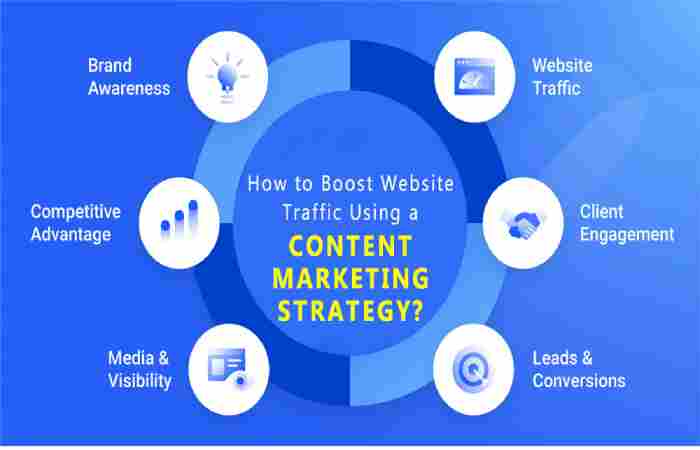How to Get Traffic with Content Marketing

If you’ve ever wondered how some websites get thousands of visitors every month without spending huge money on ads, the answer is simple — content marketing. It’s the backbone of modern SEO and digital growth. Whether you’re running a small business or a personal blog, knowing how to get traffic with content marketing can completely transform your online presence.
Let’s dive deep into the strategies, techniques, and mindset you need to drive consistent traffic using the power of content.
What is Content Marketing?
Before we talk about traffic, let’s start with the basics.
Content marketing is all about creating valuable, relevant, and consistent content to attract and engage a specific audience — and ultimately drive profitable actions like sales, sign-ups, or brand loyalty.
Unlike ads, content marketing doesn’t interrupt people. It educates, entertains, and builds trust naturally.
Some common forms include:
-
Blog posts
-
Videos
-
Infographics
-
Podcasts
-
Social media content
-
eBooks and guides
When done right, content marketing turns your website into a traffic magnet that brings people in even while you sleep.
Why Content Marketing is the Key to Getting Traffic
Search engines like Google reward websites that offer high-quality, useful content. If your content solves problems or answers questions, you’ll rank higher — and that means more visitors.
Here’s why it works:
-
Improves SEO rankings by targeting specific keywords
-
Builds authority in your niche or industry
-
Generates organic backlinks (others link to your helpful content)
-
Keeps users on your site longer, reducing bounce rates
-
Creates brand loyalty and repeat visitors
Simply put, great content = great traffic.
Step-by-Step Guide: How to Get Traffic with Content Marketing
Let’s break it down into practical, actionable steps you can start using today.
1. Know Your Target Audience
You can’t attract everyone — and that’s okay. The first rule of content marketing is understanding who you’re creating for.
Ask yourself:
-
What problems are they trying to solve?
-
What topics do they care about?
-
What search terms do they use on Google?
Use tools like:
-
Google Analytics (to see your audience demographics)
-
AnswerThePublic (for content ideas)
-
Reddit and Quora (to understand what people are asking)
Once you know your audience, you can create content that speaks directly to them — and they’ll keep coming back.
2. Do Smart Keyword Research
Traffic doesn’t just appear magically. You need to target the right keywords.
Use SEO tools like:
-
Ahrefs
-
SEMrush
-
Ubersuggest
-
Google Keyword Planner
Find low-competition, high-volume keywords related to your niche.
For example, instead of writing about “digital marketing” (very broad), go for “how to get traffic with content marketing” — a long-tail keyword that’s specific and easier to rank for.
Then, sprinkle these keywords naturally in:
-
Your title
-
Headings (H2, H3)
-
Meta description
-
Intro and conclusion
-
Image alt texts
But remember — always write for humans first, algorithms second.
3. Create High-Quality, Valuable Content
This is where the real magic happens.
Your content must educate, entertain, or inspire. Don’t just rehash what others have said — add your own insights, examples, or case studies.
Here’s how to make your content stand out:
-
Use storytelling: People love relatable examples.
-
Add visuals: Images, charts, and infographics improve readability.
-
Write in a conversational tone: Like you’re talking to a friend.
-
Keep paragraphs short and skimmable: Online readers have short attention spans.
-
Offer real value: Share tips, templates, or resources they can actually use.
When users find your content helpful, they stay longer and share it — both of which boost traffic.
4. Optimize On-Page SEO
Even the best content won’t rank if it’s not optimized properly.
Here are on-page SEO essentials:
-
Keyword in title and first 100 words
-
Descriptive meta title and description (include main keyword)
-
Internal linking (link to your other related articles)
-
External linking (cite trusted sources)
-
Optimized images (use compressed formats with alt text)
-
Readable URL structure (e.g.,
/get-traffic-with-content-marketing/)
Also, make sure your page loads fast — site speed is a ranking factor.
5. Be Consistent with Publishing
Content marketing isn’t a one-time job. It’s about consistency.
Create a content calendar and stick to it.
Whether you post once a week or twice a month, regular uploads tell Google your website is active.
Here’s what a good content schedule might include:
-
Monday: Blog post
-
Wednesday: YouTube video or infographic
-
Friday: Email newsletter
Consistency builds trust with your readers — and search engines love it too.
6. Promote Your Content Everywhere
Publishing is just half the battle — promotion is what gets eyes on your content.
Here’s how to do it effectively:
-
Social media marketing: Share snippets on LinkedIn, Twitter (X), Facebook, and Instagram.
-
Email marketing: Send new posts to your subscribers.
-
Online communities: Engage in Reddit, Quora, or niche forums (without spamming).
-
Influencer outreach: Collaborate with creators in your field.
-
Repurpose content: Turn a blog post into a video, podcast, or carousel post.
The more places your content appears, the more chances people have to discover you.
7. Build Backlinks for Authority
Google uses backlinks (links from other sites to yours) to measure credibility.
The more quality backlinks you have, the higher you’ll rank — and the more traffic you’ll get.
Here’s how to earn backlinks:
-
Guest posting: Write for other blogs in your niche.
-
Resource pages: Get featured in “Top 10” or “Best of” lists.
-
Original research or stats: Data-backed posts attract organic links.
-
Shareable visuals: Infographics get lots of backlinks.
-
Broken link outreach: Find dead links on sites and suggest your article as a replacement.
Backlinks are a long-term investment — but they’re worth every effort.
8. Update and Refresh Old Content
Don’t forget about your existing content. Over time, it can lose traffic as new competitors appear.
Here’s how to revive it:
-
Add fresh stats or recent examples.
-
Update outdated links or screenshots.
-
Improve titles and meta tags for better click-through rates.
-
Add new keywords you discovered later.
Refreshing content helps you regain rankings and drive new visitors to old posts.
9. Use Analytics to Track Results
You can’t improve what you don’t measure.
Track performance using:
-
Google Analytics (traffic, bounce rate, time on page)
-
Google Search Console (keywords, CTRs, impressions)
-
Ahrefs or SEMrush (backlinks and keyword growth)
Ask yourself:
-
Which topics drive the most traffic?
-
Where do visitors drop off?
-
Which channels (social, email, search) perform best?
Use these insights to double down on what’s working and fix what isn’t.
10. Leverage Video and Visual Content
Video content is exploding in popularity — and it’s great for driving traffic.
Try creating:
-
Short YouTube explainers
-
Instagram Reels or TikToks summarizing your blog posts
-
Visual guides or infographics
Embed these videos into your blog posts to increase dwell time and improve SEO performance.
Pro Tips to Supercharge Your Content Marketing Traffic
If you want to go the extra mile, here are a few bonus strategies:
-
Use AI tools (like ChatGPT or Jasper) for idea generation.
-
Create evergreen content that stays relevant for years.
-
Build topic clusters (main article + supporting sub-articles).
-
Add CTAs (calls-to-action) to guide visitors to your offers.
-
Engage in comments and discussions — people love creators who reply.
Common Mistakes to Avoid
Even experienced marketers slip up sometimes. Watch out for these:
-
Writing for search engines, not humans
-
Ignoring mobile optimization
-
Skipping internal links
-
Publishing without promoting
-
Focusing only on quantity instead of quality
Remember, content marketing is a long game. Patience and persistence are key.
Final Thoughts: How to Get Traffic with Content Marketing
When you master content marketing, traffic follows naturally.
It’s not about gaming algorithms — it’s about creating genuine value that people (and Google) can’t ignore.
So if you’re wondering how to get traffic with content marketing, start small:
-
Know your audience
-
Write high-quality content
-
Optimize for SEO
-
Promote consistently
-
Track and refine your strategy
Do this long enough, and your website will grow into a traffic-generating machine — powered by content that truly connects.

